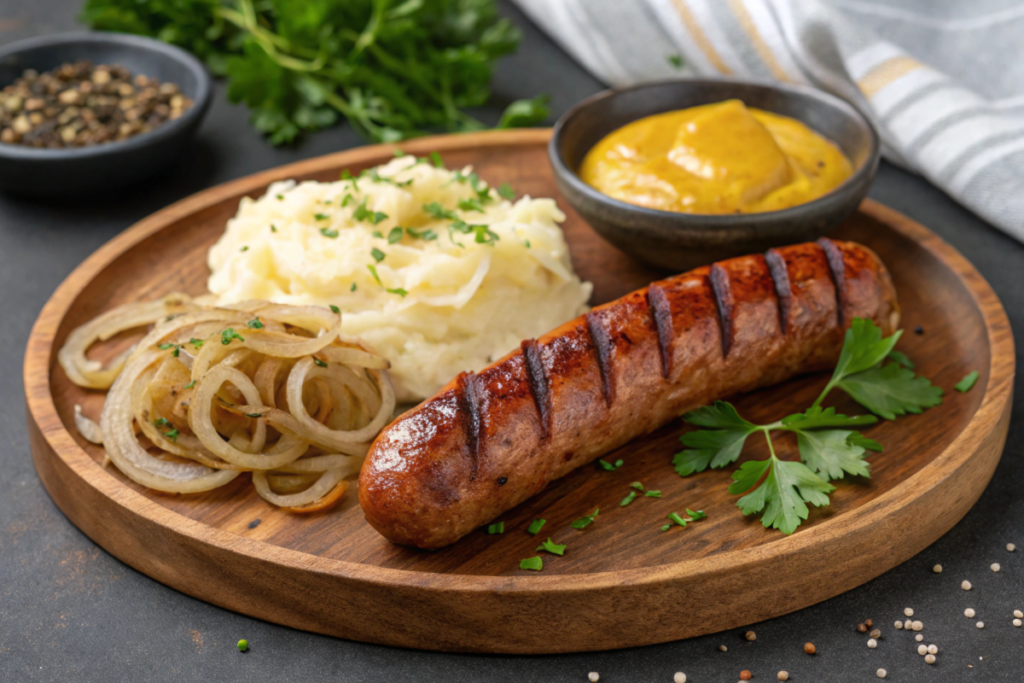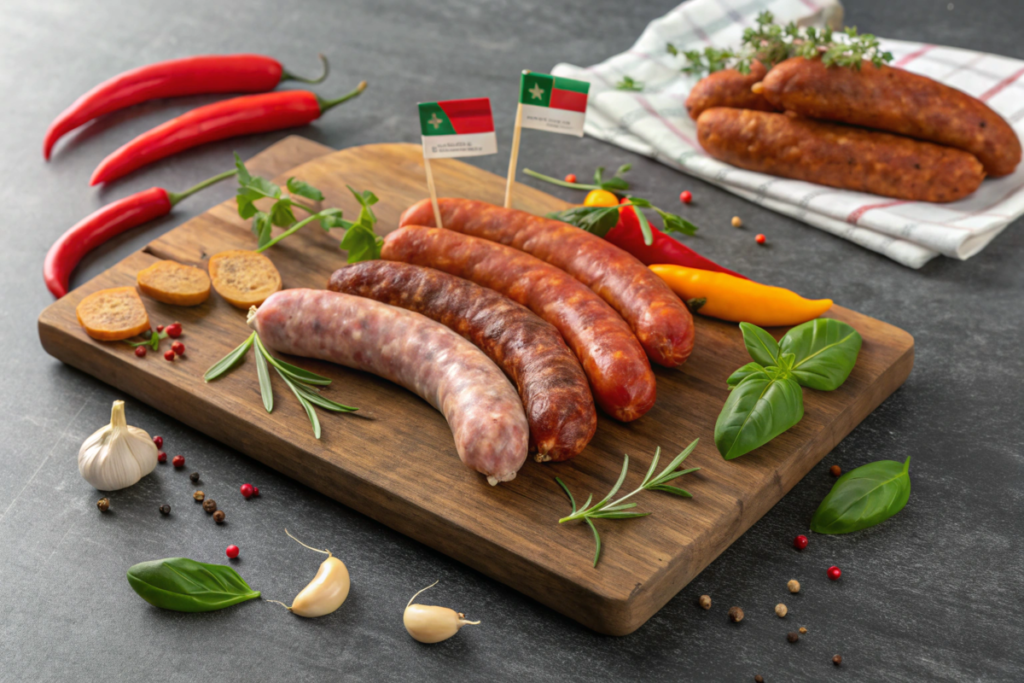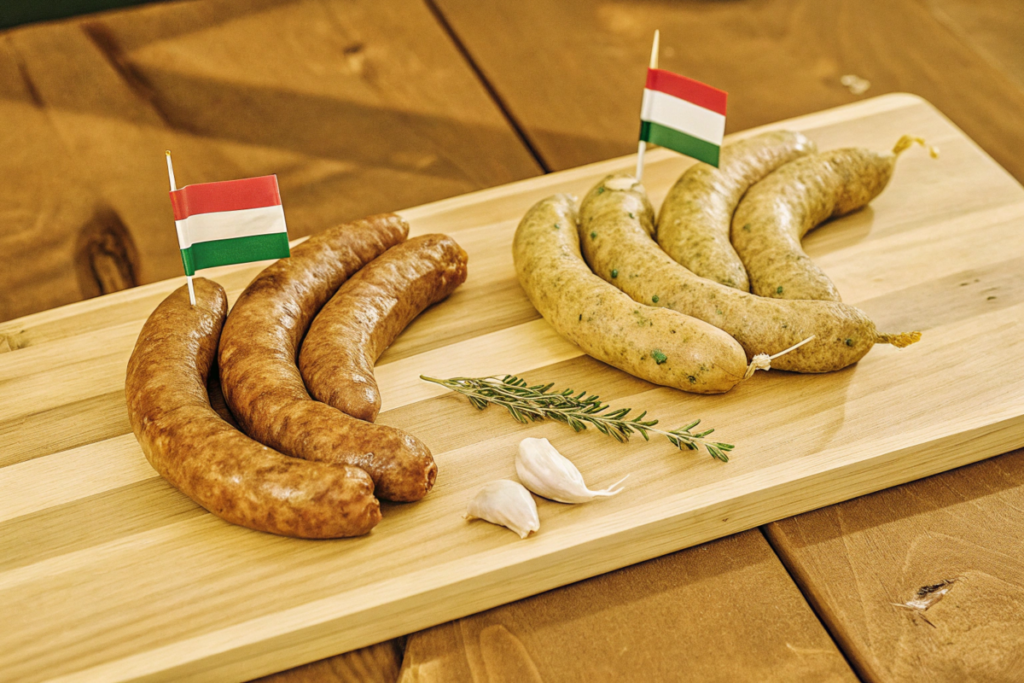Introduction
c is a versatile and flavorful food staple enjoyed across the globe. From hearty breakfasts to quick dinners, these sausages fit right into many cuisines. But what truly sets beef sausage apart? Whether you’re exploring regional varieties, delving into recipes, or curious about its nutritional benefits, this guide has you covered. We’ll also touch on cooking tips and even walk you through making your own. By the end, you’ll have everything you need to make informed and tasty choices about sausage made from beef.

Part 1: What Is?
What Makes Beef Sausage Unique?
sausage made from beef is a type of sausage primarily made from ground beef and a medley of spices. Unlike other sausages, it offers a richer flavor profile due to the natural savoriness of beef. Its texture can vary depending on the fat-to-meat ratio, giving you choices ranging from lean to indulgently fatty options.
Beef Sausage vs. Other Sausages
While pork is often the default choice for sausages, sausage made from beefbrings its own twist to the table. Compared to pork, it is firmer, with a robust taste that stands out in hearty meals. Chicken and turkey sausages are lighter alternatives, but they lack the depth of flavor that beef sausages consistently deliver.
A Quick Look at Its History
Sausage-making has a long history, dating back to ancient civilizations that sought to preserve meat. Beef sausages, specifically, have been staples in cuisines like Middle Eastern and European cooking. They reflect the ingenuity of using every part of the animal, blending it with spices for preservation and taste.
Why Beef Sausage is a Popular Choice Today
From quick weekday dinners to lavish feasts, beef sausage adapts to every occasion. Its high protein content, paired with bold seasoning possibilities, makes it a favorite for food lovers. Additionally, with growing interest in gluten-free sausage made from beef and nitrate-free options, modern variations cater to diverse dietary needs.

Part 2: Types and Varieties of
Popular Types of
Beef sausages come in various styles, each suited for different tastes and occasions. Whether you’re a fan of bold flavors or prefer something mild, there’s a type for you.
- Breakfast Sausages: These smaller-sized links are perfect for morning meals. They’re mildly seasoned with herbs like sage and thyme, complementing eggs, pancakes, or toast.
- Smoked Beef Sausages: Packed with a smoky aroma, these sausages are cured and often slow-cooked. They’re a great choice for barbecues or adding depth to stews.
- Dry-Cured Beef Sausages: Typically air-dried, these sausages boast an intense flavor, making them ideal as snacks or charcuterie board additions.
- Fresh Sausage Links: Freshly made and uncooked, these sausages are versatile for grilling, frying, or baking, offering endless possibilities in recipes.
Global Varieties of
Exploring beef sausage from around the world unveils unique seasonings and preparations that reflect diverse culinary traditions.
- Italian Beef Sausage: Seasoned with fennel and garlic, this variation adds authenticity to pasta dishes and casseroles.
- South African Boerewors: Known for its coiled shape and coriander-rich flavor, this sausage is a barbecue staple in South Africa.
- German Bratwurst (Beef Version): Though traditionally made with pork, beef versions of bratwurst offer a similar blend of mild spices, making them a hit at Oktoberfest-inspired gatherings.
- Middle Eastern Merguez: This spicy, red-hued sausage combines beef with harissa and cumin, delivering a bold kick that pairs well with flatbreads and dips.
How to Choose the Right Type for Your Meal
The type of sausage you pick should align with the dish you’re preparing. For quick breakfast bites, breakfast sausages are ideal. If you’re hosting a barbecue, smoked or boerewors sausages will impress your guests. Dry-cured varieties, on the other hand, are perfect as appetizers or snacks with cheese and crackers.
Part 3: Making Beef Sausage at Home
Creating your own homemade beef sausage is a rewarding experience that allows you to control the flavors, quality, and freshness. With the right ingredients and a clear process, you can produce sausages that rival any store-bought option. Let’s break it down into manageable sections for ease of understanding and execution.
Ingredients Needed for homemade beef sausage
To make delicious beef sausage, having the correct ingredients is crucial. Here’s what you’ll need to get started:
- Ground Beef: Use 1 kg of fresh beef with an ideal 80/20 fat-to-meat ratio. This balance ensures the sausage remains juicy and flavorful.
- Salt and Pepper: Essential for bringing out the natural taste of the beef.
- Spices: Incorporate garlic powder, paprika, fennel seeds, cayenne pepper, and onion powder to add complexity and depth.
- Fresh Herbs: Chopped parsley and thyme bring aromatic freshness to the sausage.
- Sausage Casings: Choose natural casings for an authentic texture or synthetic ones for ease of use.
Step-by-Step Process for Homemade sausage made from beef
Step 1: Preparing the Meat
Start by ensuring your ground beef is chilled. Cold meat helps maintain its texture and prevents the fat from melting prematurely. In a large bowl, mix the beef with salt, pepper, and your chosen spices. Stir until the seasonings are evenly distributed, but avoid overworking the mixture to keep it tender.
Step 2: Grinding and Mixing
If you’re using whole beef cuts, grind them with a meat grinder set to medium coarseness. Take frequent breaks to keep the meat cold during grinding. Afterward, knead the ground beef gently to ensure the seasonings are evenly incorporated, but don’t overmix, as it can lead to a dense texture.
Step 3: Preparing the Casings
Casings are an essential part of sausage-making, so handle them carefully. Rinse the casings thoroughly under cold water to remove any salt residue, then soak them in lukewarm water for about 30 minutes. This makes them soft, pliable, and easy to work with.
Step 4: Stuffing the Sausage
Here comes the exciting part! Use a sausage stuffer or a piping bag to fill the casings with your meat mixture. Be patient and gentle to avoid tearing the casings. Once stuffed, tie off the ends securely and twist the casing at regular intervals to create evenly sized sausages.
Step 5: Cooking or Storing the Sausage
After stuffing, you can either cook the sausages immediately or store them for later. Grill, pan-fry, or bake the sausages for a fresh, smoky flavor. If you’re saving them, refrigerate for up to two days or freeze them to enjoy later. Freezing is especially helpful for large batches.
Common Mistakes to Avoid
Even with a straightforward process, a few mistakes can occur. Here’s what to watch out for:
- Overmixing the Meat: Mixing the meat too much can result in dense, chewy sausages. Combine ingredients just until they’re evenly distributed.
- Improper Casing Handling: Failing to rinse or soak casings properly can lead to tears during stuffing, which can be frustrating.
By following these steps carefully and avoiding common pitfalls, you’ll be able to create homemade beef sausages that are as satisfying to make as they are to eat.
Part 4: Cooking and Serving Ideas for Beef Sausage

Popular Cooking Methods for
Cooking beef sausage unlocks its full flavor potential, and choosing the right method can elevate your meal.
- Grilling: Grilled beef sausage is a crowd-pleaser. To prevent overcooking, grill on medium heat and turn frequently.
- Pan-Frying: This quick method ensures an evenly browned exterior. Use a non-stick pan and cook on medium-high heat for 8–10 minutes.
- Baking: For hands-off cooking, bake sausages in the oven at 375°F (190°C) for about 20–25 minutes.
- Smoking: Smoking imparts a rich, woodsy flavor. Opt for hickory or applewood chips and smoke sausages at 225°F (107°C) for 2–3 hours.
Recipes Featuring sausage made from beef
Looking for inspiration? Here are three easy-to-make recipes using beef sausages:
Beef Sausage and Potato Skillet
- Ingredients: Beef sausage slices, baby potatoes, bell peppers, onions, garlic, olive oil, paprika, and parsley.
- Instructions: Sauté sausage slices in olive oil until browned. Add boiled potatoes, diced peppers, and onions. Season with paprika and garlic. Toss everything together and garnish with parsley.
Beef Sausage Pasta Bake
- Ingredients: Cooked pasta, sliced beef sausages, marinara sauce, mozzarella cheese, basil, and grated Parmesan.
- Instructions: Layer pasta, sausage, and sauce in a baking dish. Top with cheese and bake at 375°F for 25 minutes. Garnish with basil before serving.
Breakfast Burritos with Beef Sausage
- Ingredients: Beef sausage crumbles, scrambled eggs, shredded cheese, tortilla wraps, salsa, and avocado.
- Instructions: Fill tortillas with sausage, eggs, and cheese. Add a dollop of salsa and avocado slices. Roll up tightly and serve.
Pairing Beef Sausage with Sides and Sauces
Beef sausages shine when paired with complementary sides and sauces.
- Traditional Choices: Creamy mashed potatoes, tangy sauerkraut, or crusty bread.
- Unique Pairings: Chimichurri sauce for a zesty kick or coleslaw for a crunchy contrast.
- Sauces: Classic mustard, barbecue sauce, or a smoky aioli to enhance flavor.
Part 5: Health and Nutrition of Beef Sausage
Beef sausage, aside from being a flavorful delight, is surprisingly nutrient-rich, making it a great addition to a balanced diet. Let’s take a closer look at its benefits, concerns, and how to make healthier choices without sacrificing taste.
Nutritional Benefits
When enjoyed in moderation, beef sausage offers a wealth of nutrients that contribute to overall well-being.
- High Protein Content: Packed with protein, beef sausage plays a critical role in tissue repair and immune system support. Plus, protein helps keep you energized throughout the day.
- Micronutrient Boost: It’s a great source of iron, zinc, and vitamin B12—three essential nutrients. Iron supports oxygen transport in the blood, zinc strengthens immunity, and B12 boosts energy and cognitive function.
- Energy-Dense and Filling: Since beef sausage is calorie-dense, it provides long-lasting energy. This makes it a practical option for those with active lifestyles.
However, while beef sausage delivers plenty of benefits, it’s also vital to recognize potential drawbacks, especially with highly processed versions.
Concerns About
Like many processed meats, beef sausage comes with some health considerations. Yet, by making mindful choices, you can minimize these concerns.
- Fat and Cholesterol Levels: Certain varieties contain high levels of saturated fat, which can contribute to cholesterol buildup. Opt for leaner versions or smaller portions to manage intake.
- Additives and Preservatives: Commercially made sausages often include sodium nitrates or phosphates. While these additives improve shelf life, excessive consumption may have adverse health effects.
Tips for Choosing Healthier Beef Sausages
There’s no need to eliminate beef sausage from your diet. Instead, follow these tips to enjoy a healthier option:
- Check Labels Carefully: Look for products marked as “low sodium” or “nitrate-free” to reduce the intake of potentially harmful additives.
- Select Natural Sausages: Sausages made with minimal processing and all-natural ingredients are a healthier choice.
- Choose Gluten-Free Options: For those with gluten sensitivities, many brands now offer gluten-free beef sausage varieties.
By understanding both the benefits and concerns associated with beef sausage, you can make informed dietary choices. With moderation and healthier alternatives, you can indulge in this savory treat while supporting your wellness goals.
Part 6: FAQs About
To answer some common questions, here’s a comprehensive FAQ section about beef sausage. Whether you’re curious about its preparation, dietary compatibility, or storage, we’ve got you covered.
How is beef sausage different from pork sausage?
Beef sausage is richer and bolder in flavor compared to pork sausage, which tends to have a milder and sweeter taste. Additionally, beef sausage is preferred for dietary reasons, such as being kosher or halal-friendly.
Can I freeze beef sausages, and how should I do it?
Absolutely! Beef sausages freeze well, provided they are stored correctly. Wrap each sausage in plastic wrap or place them in an airtight freezer bag. Label them with the date to keep track. When ready to use, defrost overnight in the refrigerator for the best results.
Are there gluten-free beef sausages available?
Yes, many brands offer gluten-free options. These cater to those with dietary restrictions, ensuring you can enjoy your meal worry-free. If you prefer full control over ingredients, making homemade sausages is an excellent alternative.
What’s the best beef sausage for grilling?
Smoked or fresh beef sausages are perfect for grilling. Their firm texture holds up beautifully on high heat, and the natural fat content ensures they remain juicy. Varieties like South African boerewors and Italian-style sausages are especially popular for barbecues.
Is beef sausage suitable for keto or low-carb diets?
Yes! Most beef sausages are keto-friendly because they’re high in protein and low in carbohydrates. Be sure to check the label for hidden sugars or starches that could add unnecessary carbs.
How long does beef sausage last in the fridge?
Fresh beef sausage typically lasts 1–2 days in the refrigerator when stored below 40°F (4°C). Vacuum-sealed varieties can last up to a week. Always rely on your senses—if it smells odd or feels slimy, it’s time to discard it.
Armed with these answers, you can confidently enjoy beef sausage while keeping practicality and safety in mind. Let me know if you’d like to revisit or expand any sections!
Part 7: Conclusion and Final Thoughts
When it comes to versatile, flavorful, and satisfying food options, beef sausage stands out as a true winner. From its rich history and global varieties to the ease of making it at home and countless recipes it inspires, beef sausage offers something for everyone. Moreover, whether you’re savoring it grilled at a summer barbecue, pan-fried for a quick breakfast, or baked into a hearty casserole, its adaptability makes it a star ingredient in any kitchen.
Furthermore, understanding its nutritional benefits helps you make better choices while enjoying your favorite meals. By selecting leaner options or those labeled nitrate-free and gluten-free, you can incorporate beef sausage into your diet without worry. Plus, for those who prefer homemade solutions, creating your own beef sausage allows you to control every ingredient while tailoring flavors to suit your taste.
In addition to its culinary appeal, beef sausage connects cultures and cuisines across the globe. Italian beef sausages bring a burst of Mediterranean flavors, South African boerewors evoke smoky barbecues, and Middle Eastern merguez delivers a fiery kick. Exploring these varieties not only expands your palate but also adds a touch of adventure to your meals.
Finally, whether you’re a seasoned cook or just beginning your culinary journey, this guide equips you with the knowledge to appreciate and prepare sausage made from beef in its many forms. It’s not just about indulging in delicious food but also embracing the stories, techniques, and creativity that come with it.
So, why wait? Dive into the world of beef sausage, try new recipes, experiment with spices, and explore global flavors. Your taste buds will thank you, and your meals will never be the same again!